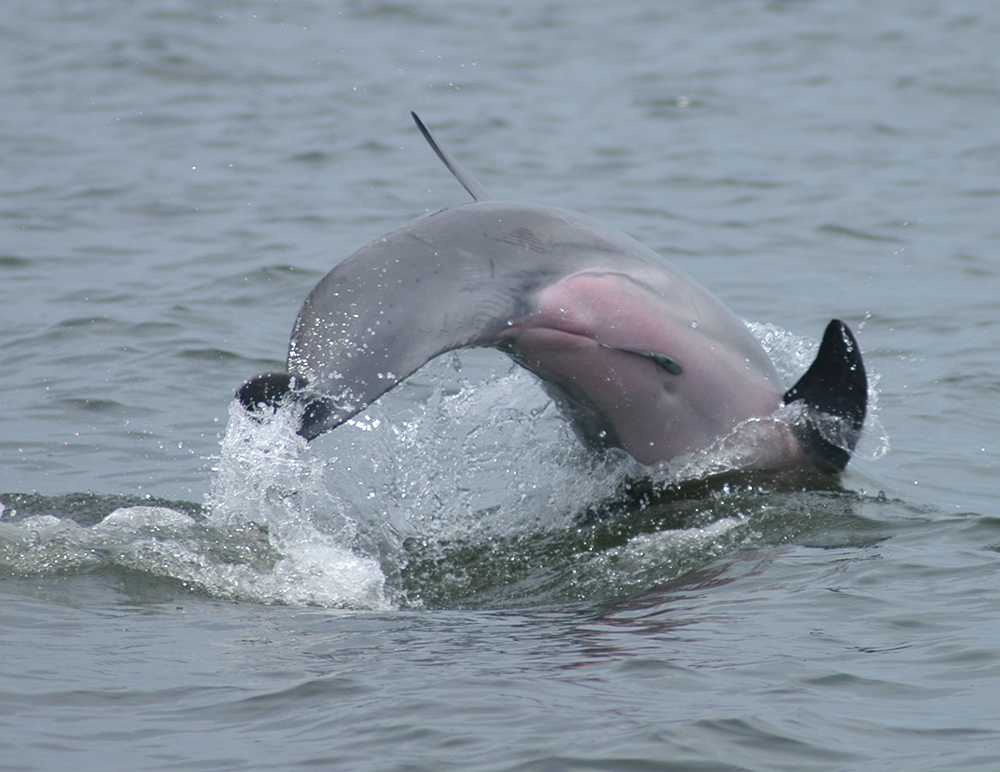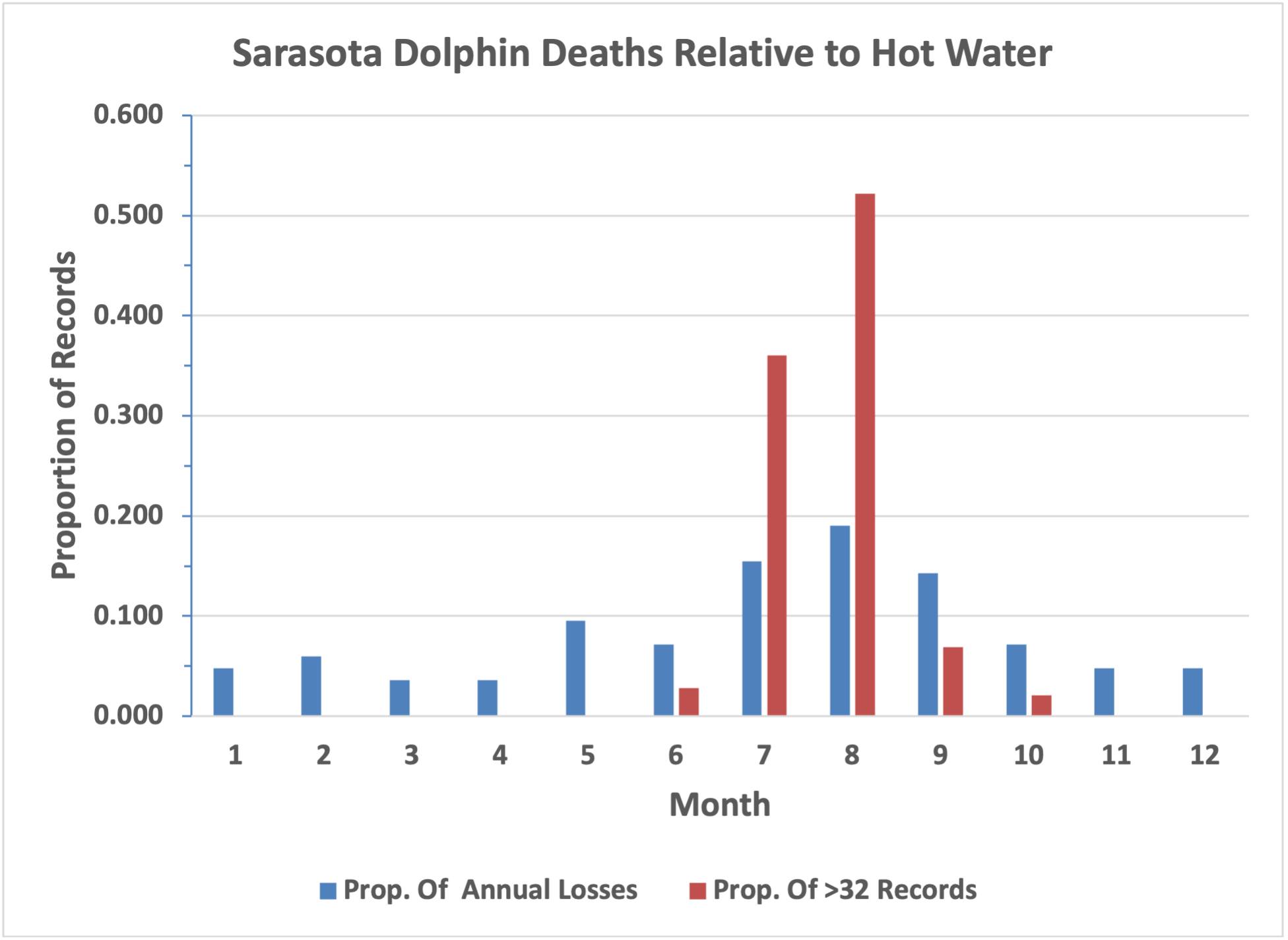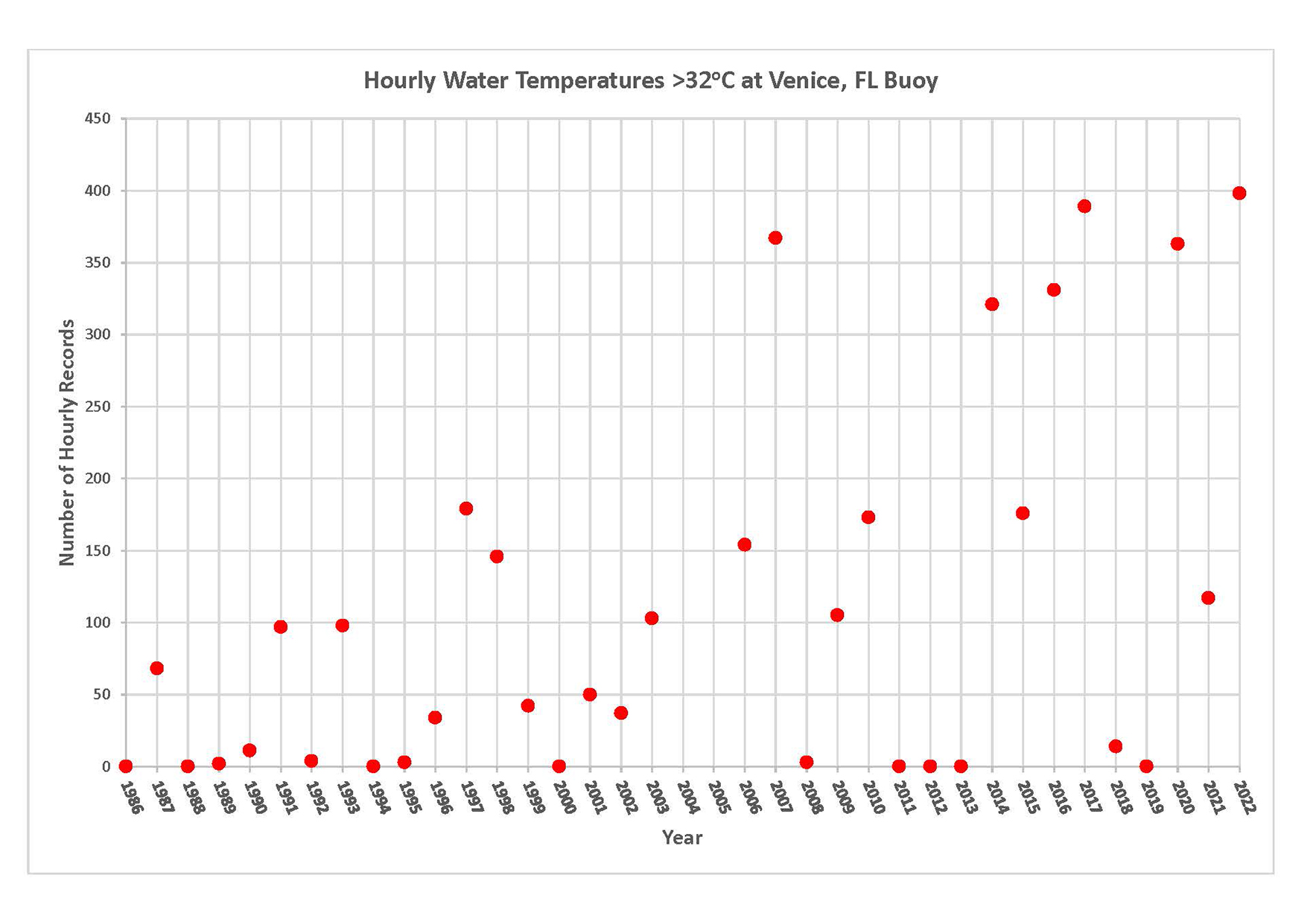Feeling the Heat During a Hot Summer
People around the world are feeling extreme heat this summer and we’re receiving a lot of questions about what the heat might mean for dolphins.
In 2010, we wrote an article about potential impacts of climate disruption on the resident dolphins of Sarasota Bay. We thought now would be an opportune time to update some of the key points we made in that article.
Like us, dolphins are mammals, and they are warm-blooded. They produce heat through metabolic processes, and, like us, they need to be able to shed excess body heat.
Because they live in water, other mammalian approaches to offload heat — such as sweating and panting — are not available to them. Instead, they dump heat to their environment by sending warmer blood to the outer surfaces of their bodies, including their fins, and having the excess heat dissipate into the cooler water that surrounds them.

This picture shows the pink belly of a leaping Sarasota dolphin in July 2023. The pink color is caused by the redirection of blood flow. (Note the gray remora, or suckerfish, attached to the dolphin’s belly.)
This redirection of blood flow to their periphery is what sometimes makes the bellies of active dolphins appear pink in the summer.
Our research with scientists at the University of California, Santa Cruz, has shown that dolphins actually have a higher metabolic rate and produce more heat in summer than in winter when their added blubber helps to insulate them from cold water, which further exasperates the problem of getting rid of excess heat.
Typically, the dolphins’ system to regulate temperature works well as long as the surrounding water is cooler than their bodies. Concerns arise, however, as the water temperatures begin to approach the dolphins’ body temperatures (~98 F, 37 C).
What happens to the health of the dolphins at the warmest water temperatures? Do they become heat-stressed, and if so what does this mean?
At this point we have not clearly identified any cause-and-effect relationships, but preliminary investigation suggests that conditions associated with warmer waters are worse for the dolphins than those associated with colder temperatures.
We compared the distribution of the proportion of Sarasota resident dolphin deaths across the year (based on Mote Marine Laboratory stranding data) to that of the occurrence of the highest hourly water temperatures recorded at the NOAA weather station at Venice Pier, Florida.

The blue bars in the graph above indicate the proportion of annual dolphin deaths occurring during a given month (not including calves less than 2 years old or deaths caused by human interactions). Red bars show the proportion of annual hourly temperature records of 90 F, (32 C) occurring during a given month. The peaks for the highest temperatures and most deaths coincide during July-September. To date in 2023, water temperatures have reached 87 F (31 C).
No hourly water temperature records of more than 90 F (32 C) have been recorded at the NOAA station along the Gulf coast of Venice since the beginning of the dataset in 1986, though we have recorded higher readings on occasion during our dolphin population monitoring surveys through bay waters.

Looking from left to right in the graph above here, you can see the number of records of high temperatures in any given year is increasing, and the variability, that is, the number of years with no extreme records, in water temperature is also increasing. While determining what happens next relative to water temperature changes is not an experiment we sought to do, we are positioned to be able to document changes thanks to our unique long-term datasets.
We have hypothesized the following as potential climate change impacts on dolphins:
Warmer waters might:
- Limit dolphins’ cooling ability if water temperature equals or exceeds body temperature.
- Require increased food intake to support increased metabolic rates.
- Change prey species availability due to temperature, pH, depth and/or salinity changes.
- Allow new pathogens to invade.
- Prolong the seasonal exposure of dolphins to pathogens.
- Increase the frequency and intensity of harmful algal blooms (red tides).
- Change the frequency and intensity of hurricanes
Our studies of offshore dolphins are showing that they, too, are facing increased temperatures. The readings from the offshore dolphins that we tagged in May are showing sea surface temperatures of 87-89 F (31-32 C). However unlike their inshore cousins, offshore dolphins have the option of diving to cooler depths.
As we continue to investigate the effects of extreme heat on dolphins, let’s hope that the current wake-up call of temperature extremes across the globe leads to much-needed actions by humans to help keep the impacts of climate disruption to a minimum.
Further Reading
A recent study published in the American Meteorological Society’s Journal of Climate shows that the Gulf of Mexico sea surface temperature (SST) increased by approximately 1 C (1.8 F) between 1970 and 2020 — equivalent to a warming rate of approximately 0.19 C (0.34 F) per decade. That means that the SST of the Gulf of Mexico warmed at twice the rate of warming in the global ocean.
- Learn more
- Study citation & link: Wang, Z., T. Boyer, J. Reagan, and P. Hogan, 2023: Upper-Oceanic Warming in the Gulf of Mexico between 1950 and 2020. J. Climate, 36, 2721–2734, https://doi.org/10.1175/JCLI-D-22-0409.1.
Another study published in the journal Nature shows that the changing climate is also changing the color of our oceans — making them greener over the past 20 years.
- Learn more
- Study citation & link: Cael, B.B., Bisson, K., Boss, E. et al. Global climate-change trends detected in indicators of ocean ecology. Nature (2023). https://doi.org/10.1038/s41586-023-06321-z




